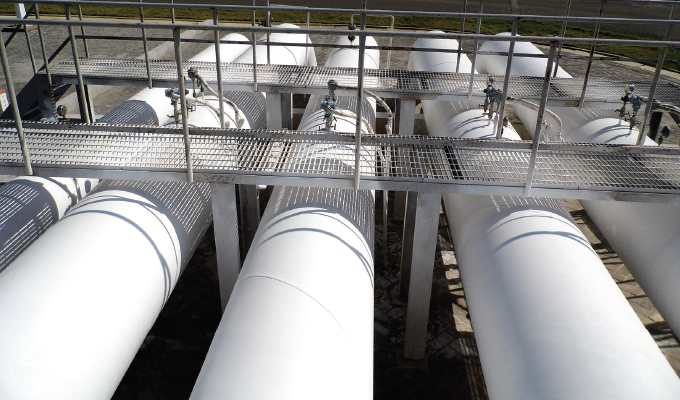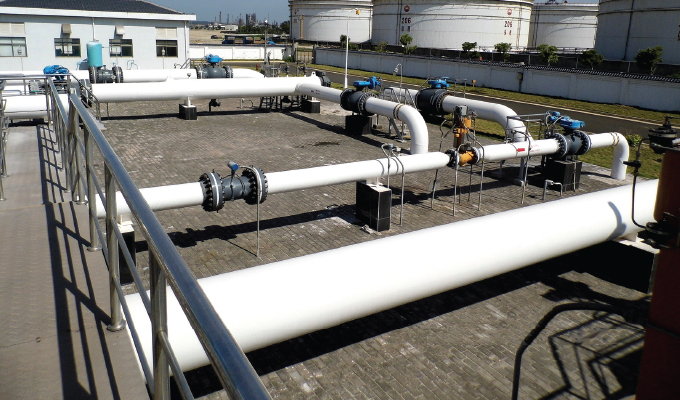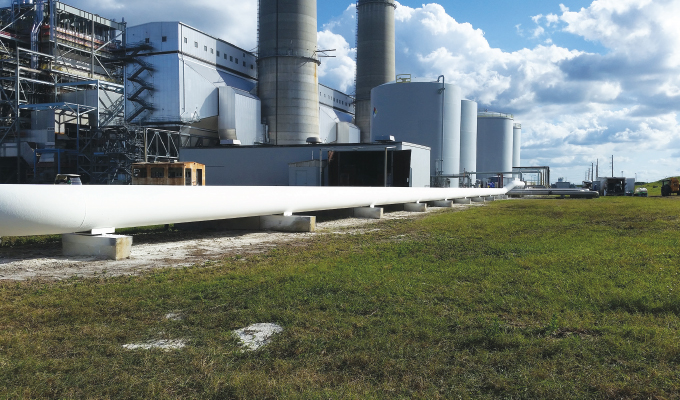When an electric utility in the Southeastern United States sought to protect above ground natural gas pipeline against corrosion, the goal was to cost effectively do so while minimizing downtime and environmental impact.
Yet in the power and petrochemical industries, protecting above ground pipeline from corrosion can be a challenge, particularly when the pipeline carries a cooled compressed gas that draws moisture out of a hot or humid external environment. This causes in use pipeline to continuously drip water, or “sweat,” making adhering a protective coating to the exterior of the pipeline virtually impossible without shutting down the line.
Traditional organic coatings also typically require days or even weeks of facility downtime depending on the project, due to complex surface preparation and application as well as curing times needed between coats. This can be tremendously expensive in terms of lost production as well as shut down and start up costs.
Utilizing such coatings near people or sensitive areas can also be problematic because they typically involve dangerous volatile organic compounds (VOCs) and hazardous air pollutants (HAPs), as well as clean up using harmful turpentine or mineral spirits.
Therefore, when the electric utility chose an anti-corrosive coating for about 3,500 feet of power plant pipeline in a facility, it was very particular about its selection. The 30-inch diameter pipeline connects down to smaller diameter pipe that feeds natural gas boilers at the power plant. The boilers provide steam to two 858 MW steam turbines.
Because the power plant is located near a freshwater preserve teeming with wildlife, the electric utility is very attentive to its environmental stewardship. Accordingly, the electric utility turned to EonCoat, a spray applied inorganic coating from the Raleigh, North Carolina-based company of the same name, for use on the pipeline. EonCoat represents a new category of tough, chemically bonded phosphate ceramics (CBPCs) that can stop corrosion even when applied on in use, wet, “sweaty” pipeline. This eliminates the need to shut down the pipeline for maintenance while also eliminating dangerous VOCs and HAPs.

IN USE PIPELINE CORROSION PROTECTION
Unlike traditional coatings, the CBPC coating is designed to apply over wet pipe because it is water based, ceramic, and initially porous before setting. This allows any excess water to vent out of the coating during the application process.
In contrast to traditional polymer coatings that sit on top of the substrate, the corrosion resistant CBPC coating bonds through a chemical reaction with the substrate. An alloy layer is formed. This makes it impossible for corrosion promoters like oxygen and humidity to get behind the coating the way they can with ordinary paints.
Although traditional polymer coatings mechanically bond to substrates that have been extensively prepared, if gouged, moisture and oxygen will migrate under the coating’s film from all sides of the gouge.
By contrast, the same damage to the ceramic coated substrate will not spread corrosion on the pipeline because the carbon steel’s surface is turned into an alloy of stable oxides. Once the steel’s surface is stable (the way noble metals like gold and silver are stable) it will no longer react with the environment and cannot corrode.
Visible in scanning electron microscope photography, EonCoat does not leave a gap between the steel and the coating because the bond is chemical rather than mechanical. Since there is no gap, even if moisture was to get through to the steel due to a gouge, there is nowhere for the moisture to travel. This effectively stops atmospheric corrosion of power and petrochemical industry pipeline and steel assets.
The corrosion barrier is covered by a ceramic shell that further resists corrosion, water, fire, abrasion, impact, chemicals, and temperatures up to 842 degrees Fahrenheit (450 degrees Celsius). Beyond this, the ceramic shell serves a unique role that helps to end the costly maintenance cycle of replacing typical barrier type coatings every few years.
In power and petrochemical assets such as compressed gas pipelines, if the ceramic shell and alloy layer are ever breached, the ceramic shell acts as a reservoir of phosphate to continually re-alloy the steel. This “self heals” the breach, depending on its size, and stops the corrosion if necessary.
This capability, along with the coating’s other properties, enables effective corrosion protection for the life of the asset with a single application.

EASY APPLICATION, ENVIRONMENTAL BENEFITS
In the electric utility pipeline project, water jetting the pipeline’s exterior was sufficient to clean and prepare the surface for coating, since only a NACE 3 / SSPC-SP 6 /WJ-1 commercial blast cleaning is needed.
The CBPC coating was successfully applied to the exterior of the “sweating” in use natural gas pipeline outside the facility when atmospheric temperature was 87 degrees Fahrenheit (30 degrees Celsius).
Such CBPC coatings consist of two non-hazardous components that do not interact until applied by a standard industrial plural spray system like those commonly used to apply polyurethane foam or polyurea coatings.
While EonCoat is normally spray applied at a thickness of 20 mils before a topcoat is applied, in this case the CBPC coating was deliberately applied at 25 mils and no topcoat was used to deter mold growth on the pipeline’s exterior. The high pH of the inorganic coating tends to retard mold growth when used without a topcoat, even in a hot, humid environment.
Because of the ceramic coating’s multiple layers of corrosion protection, and the ability to “self heal” breaches, the power plant is on track to see long term protection of its pipeline, effectively eliminating the traditional cycle of blasting and recoating during costly shutdowns.
The electric utility also met its environmental goals with this approach. The CBPC coating is inorganic and non-toxic, so there are no VOCs, no HAPs and no odor. The coating is also non-flammable. This enhances safety not only for plant personnel but also for the wildlife of the nearby freshwater preserve.
With atmospheric corrosion a perennial problem for owners or operators of any pipeline that carries compressed gas, whether for natural gas fired power plants or midstream oil and gas companies, the utilization of CBPC coatings that can control corrosion for decades will only help the bottom line and protect the environment.
FOR MORE INFORMATION
Siemens Digital Industries Software, a business unit of Siemens Digital Industries, is a leading global provider of software solutions to drive the digital transformation of industry, creating new opportunities for manufacturers to realize innovation. With headquarters in Plano, Texas, and over 140,000 customers worldwide, we work with companies of all sizes to transform the way ideas come to life, the way products are realized, and the way products and assets in operation are used and understood. For more information, visit www.sw.siemens.com.
Merrick Alpert is president of EonCoat. EonCoat manufactures and sells its patented EonCoat® anti-corrosive coating to large industrial customers throughout the world. EonCoat is focused on preventing corrosion on a wide scale, and the company only works with corporations of significant size, often those that are publicly traded with multinational operations. For more information, call 754.222.4919 or visit www.eoncoat.com.
MODERN PUMPING TODAY, June 2019
Did you enjoy this article?
Subscribe to the FREE Digital Edition of Modern Pumping Today Magazine!



